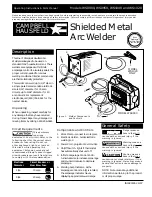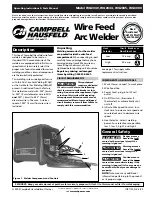
V4.2
200A AC/DC Dial Control TIG Welder 202KE
8785081
Visit www.princessauto.com for more information
19
AC TIG
– Primary welding method for aluminum, magnesium and their metal alloys
Pulse AC TIG
– Primary welding method for aluminum, magnesium and their
metal alloys. Reduces the welding heat input in the same way as Pulse DC TIG
to obtain a better weld.
DC Stick
– Wide variety of electrodes are an option. DC stick arc is stable and
smoother than the AC stick arc. DC positive polarity results in higher material
penetration while DC negative is better at material deposition.
WELDING PARAMETERS
Each welding parameter has an adjustable range that you can set based on the
type of welding and welding materials. Some welding parameters do not apply
to all welding methods.
Current(A)
– Available for all welding modes.
Adjust the amount of amps (heat) being applied to the weld. See Specifications
for the ranges available based on the type of welding and amount of voltage
being supplied (120/230V).
DC current is constant application of power to the weld.
AC current polarity switches between negative and positive, completing a cycle.
Pulse Frequency(Hz)
– Available for Pulse DC TIG.
Adjust the frequency for a slower or quicker pulse. Pulse TIG creates a neater
weld and allows you to adjust the speed of creating the weld. The lower the
pulse the less overall heat is applied to the weld and material.
AC Frequency(Hz)
– Available for AC TIG and Pulse AC TIG.
A higher frequency creates a narrower arc cone, penetrating deeper into the
material and forming a narrower bead weld with less build up. A lower
frequency will create a broad arc cone, with less penetration and more bead
build up.
AC Balance(%)
– Available for AC TIG and Pulse AC TIG.
The electrode positive phase penetrates the material. The electrode negative
phase cleans (etches) the area around the weld of oxides, reducing the welding
temperature needed for aluminum and magnesium. The unadjusted AC balance
is approximately 50% penetrating (EP), 50% cleaning (EN).
















































